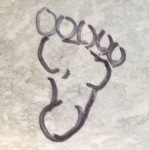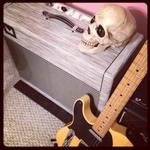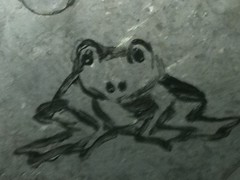[quote="mrpicard"]As promised, here is the Bone Bender 1 Schema:
Hi there,
thank you mrpicard,
Here's short tour through the circuit. The first stage in a Mark 1 is a buffer and it was made with a germanium transistors and the first run of Bone Benders were made like this. However as I consider the buffer having little impact on sound while on the look out for ways to reducing noise I decided to try a J-Fet and the adjusted the inputimpedance to be more similar to what could be expected from a germanium transistor and that is seen in the choice of R1 that effectively sets the inputimpedance of the J-Fet as that has an internal impedance of several Mega Ohm's; for a germanium transistor input impedance is roughly calculated as hie+hfe times the emitter load and thus is a little less predictable and varies with setting of Attack control but I set R1 empirically while listening to how volume control on guitar reacted and top treble and decided 300K was about fine.At buffer output comes Attack control that effectively limits gain of circuit by the divider it forms with the input impedance of gain stage 1. Gain stages 1&2 are made similar and both are set up with traditional stabilization networks for a transistor- note though that since germanium transistors have a leakage current from Collector to base known as Icb and that Icb is a variable between the germanium transistors the stabilization network must take this into account ( for silicon transistors of modern kind Ibc is generally so small it can be ignored for all practical purposes- not so with germanium transistors as those can even be turned on into working state by virtue of Ibc) while in the circuit there's a trimmer to each base so linear at very small signals response can be set- how to do this is described above in a Guitarit's Approach to Biasing Fuzzes. There are two caps one for each gain stage between collector and base and those are amplified by the Miller effect so their true value is gain times pF+ ghost Miller cap,that is formed internally to the transistor- Values of those caps were set empirically to limit upper treble just above 'vital' treble as in just above where a loss was perceived. Finally there's a Volume control and the circuit since it uses all NPN and N-channel J-Fet is negatively grounded and the B-tree is supplied with a decoupling capacitor and series filter resistor and also polarity protection and there's an LED connected to show status of fuzz as in activated or not activated and because of this the fuzz can be driven from a standard +9V supply and it is fairly stable to Voltage fluctuations so there is no real benefit from running the circuit from a battery while it certainly can be driven by a battery. However sound will differ with differing Voltage and on some supplies Voltage can be manually set from say 4,5V to 9V and of course at lower voltages sound will saturate sooner.
Difference between the versions are noted in the schematic and notice since there's ample trimming range any typical germanium NPN transistor can be used in the circuit and be biased but biasing must be performed if linear to small signal conditions shall apply.
I am greatly looking forward to hearing thoughts on the Bone Bender 1 design both from those that have a BJF and those that build one themselves and speaking of DIY if anybody would like to do a vero layout et.c I'd much appreciate that.
Have fun
BJ
>>> Sparkle Face Research Project <<<
Moderator: Moderators
-

BJF - Posts: 522
- Joined: Tue Feb 27, 2007 4:43 am
- Location: Stockholm
- Guitars:: Les Pauls, V with P-90's and humbuckers, strats,tele duo-jet and expanding; pick ups mostly Lundgren or BJF/ Lundgren
Danelectro Barython - amps: MP CS-40, MP101, Hiwatt Custom 200, Hiwatt Custom 100, VOX AC15
Fender Blues De Ville, Fender Super Reverb, Marshall 5150 through various speakers - pedals: 42
Re: >>> Sparkle Face Research Project <<<
When I get some free time I'll come up with a layout for the Bone bender 1, hopefully more people will get on board to give their opinions on it. I'm still having lots of fun with the DIY Sparkle face I built, Usually have settings of vol 1-2 O'clock, saturation 9 O'clock, and fuzz at 9 O'clock. This is then stacked into My HB which gives me a very balanced sound with plenty of lows into my vox, a very musical blues sound that is just to die for. Looking forward to trying a different Fuzz with your stamp on.
Bill
Bill
- Baggy
- Posts: 28
- Joined: Fri Oct 28, 2016 8:44 am
- Guitars:: Fender 72 Telecaster Thinline reissue 2002, Gibson Flying v 2016 T, Gibson Les Paul Custom Classic lite 2016.
- amps: Vox AC4C1
- pedals: 2
Re: >>> Sparkle Face Research Project <<<
cajone5 wrote:I'm looking forward to making a sparkle face. Seems I'm always 6-12 months behind where I'd like to be. I have no idea how anyone does this full time and maintains their sanity
This

Thanks for the technical explanation BJ! Clearly bringing together all of the great aspects we love about fuzz and fine tuning it for better performance while retaining what makes it great in the first place
I think leakage current is fascinating... is it right to say that the success of a fuzz largely rests upon understanding this correctly?
"The music business is a cruel and shallow money trench, a long plastic hallway where thieves and pimps run free, and good men die like dogs. There's also a negative side." - Hunter S. Thompson
-

ak47 - Posts: 421
- Joined: Tue Dec 20, 2011 5:52 pm
- Location: Sweden
- pedals: 0
Re: >>> Sparkle Face Research Project <<<
Bumping this great thread.... Anyone got a BJFE 109 Fuzz? Not heard much on this one.
I have the Bone Bender Mk1 3k and it is a great pedal, very dynamic with big balls, and have just pulled the plug on a 109 which I should get in a week or so.
Cheers,
Sean
I have the Bone Bender Mk1 3k and it is a great pedal, very dynamic with big balls, and have just pulled the plug on a 109 which I should get in a week or so.
Cheers,
Sean
BJFE: HBOD, BBOD deluxe, Bone Bender kit, 109 Fuzz, PGC
- seans
- Posts: 225
- Joined: Mon Jun 02, 2008 4:27 am
- Location: UK
- Guitars:: Gibson LP Goldtop w. Bearknuckle P90s , Danocaster Blackguard Telecaster
- amps: 1963 AC30, LazyJ J20
- pedals: 0
Re: >>> Sparkle Face Research Project <<<
seans wrote:Bumping this great thread.... Anyone got a BJFE 109 Fuzz? Not heard much on this one.
I have the Bone Bender Mk1 3k and it is a great pedal, very dynamic with big balls, and have just pulled the plug on a 109 which I should get in a week or so.
Cheers,
Sean
I bought a Fuzz 109. The black and gold leaf one. It's really, really good. Just a fantastic FF... I've had other Fuzz Faces throughout the years and compared to those, the Fuzz 109 definitely stands above all but the Sunface I used to have. It was also fantastic, but a bit of a different flavor... more wooly and loose. The Fuzz 109 is warm and just squishy enough. It cuts through well and is articulate without being harsh or strident on the upper end... An issue that some of my silicon/brighter Fuzz Faces have had in the past. I was going to get another Sunface - a TI/UK - when I saw that this one was available. Knowing how perfectly Bjorn's designs always suit me, I figured it was a no-brainer...
This one's voiced just right, so it's staying for sure.
My rainbow of BJFe:
BJFe.org CB --> RRB --> PGC --> CAF 4K -->AWF! --> "Bjorn again" Phase 90 -->BBOD --> EGDM --> MG --> SBEQ --> BPB --> BJFe Echoverb
BJFe.org CB --> RRB --> PGC --> CAF 4K -->AWF! --> "Bjorn again" Phase 90 -->BBOD --> EGDM --> MG --> SBEQ --> BPB --> BJFe Echoverb
-

Your name here - Posts: 370
- Joined: Thu Aug 26, 2010 10:55 pm
- Location: USA - Texas
- Guitars:: Main Guitars: Nocaster, 1962 Strat, ES335, PRS McCarty, Jaguar, Danelectros...
- amps: Morgan AC20 Deluxe 1x12, brown Princeton, Silvertone 1482, Ampeg Gemini II, '63 Vox AC30, Harmony h430, Dr. Z Mini Z combo, Alamo Montclair... Etc...
- pedals: 50
Re: >>> Sparkle Face Research Project <<<
Your name here wrote:seans wrote:Bumping this great thread.... Anyone got a BJFE 109 Fuzz? Not heard much on this one.
I have the Bone Bender Mk1 3k and it is a great pedal, very dynamic with big balls, and have just pulled the plug on a 109 which I should get in a week or so.
Cheers,
Sean
I bought a Fuzz 109. The black and gold leaf one. It's really, really good. Just a fantastic FF... I've had other Fuzz Faces throughout the years and compared to those, the Fuzz 109 definitely stands above all but the Sunface I used to have. It was also fantastic, but a bit of a different flavor... more wooly and loose. The Fuzz 109 is warm and just squishy enough. It cuts through well and is articulate without being harsh or strident on the upper end... An issue that some of my silicon/brighter Fuzz Faces have had in the past. I was going to get another Sunface - a TI/UK - when I saw that this one was available. Knowing how perfectly Bjorn's designs always suit me, I figured it was a no-brainer...
This one's voiced just right, so it's staying for sure.
Looks like a signature update is in order then


Timing has a lot to do with the outcome of a rain dance.
BJFe: DIY CB, DIY FF 3.5%
BJFe: DIY CB, DIY FF 3.5%
-

cajone5 - Posts: 931
- Joined: Wed May 19, 2010 9:44 am
- Location: Austin, TX
- Guitars:: 2006 Taylor 214e
2014 Fender Strat 60th Anniversary
Mainland Tenor Uke - amps: 5e3 Deluxe
'68 Custom Deluxe Reverb - pedals: 99
Re: >>> Sparkle Face Research Project <<<
cajone5 wrote:
Looks like a signature update is in order then
Give it a few more days. I have a couple more things on the way....

My rainbow of BJFe:
BJFe.org CB --> RRB --> PGC --> CAF 4K -->AWF! --> "Bjorn again" Phase 90 -->BBOD --> EGDM --> MG --> SBEQ --> BPB --> BJFe Echoverb
BJFe.org CB --> RRB --> PGC --> CAF 4K -->AWF! --> "Bjorn again" Phase 90 -->BBOD --> EGDM --> MG --> SBEQ --> BPB --> BJFe Echoverb
-

Your name here - Posts: 370
- Joined: Thu Aug 26, 2010 10:55 pm
- Location: USA - Texas
- Guitars:: Main Guitars: Nocaster, 1962 Strat, ES335, PRS McCarty, Jaguar, Danelectros...
- amps: Morgan AC20 Deluxe 1x12, brown Princeton, Silvertone 1482, Ampeg Gemini II, '63 Vox AC30, Harmony h430, Dr. Z Mini Z combo, Alamo Montclair... Etc...
- pedals: 50
Re: >>> Sparkle Face Research Project <<<
Your name here wrote:seans wrote:Bumping this great thread.... Anyone got a BJFE 109 Fuzz? Not heard much on this one.
I have the Bone Bender Mk1 3k and it is a great pedal, very dynamic with big balls, and have just pulled the plug on a 109 which I should get in a week or so.
Cheers,
Sean
I bought a Fuzz 109. The black and gold leaf one. It's really, really good. Just a fantastic FF... I've had other Fuzz Faces throughout the years and compared to those, the Fuzz 109 definitely stands above all but the Sunface I used to have. It was also fantastic, but a bit of a different flavor... more wooly and loose. The Fuzz 109 is warm and just squishy enough. It cuts through well and is articulate without being harsh or strident on the upper end... An issue that some of my silicon/brighter Fuzz Faces have had in the past. I was going to get another Sunface - a TI/UK - when I saw that this one was available. Knowing how perfectly Bjorn's designs always suit me, I figured it was a no-brainer...
This one's voiced just right, so it's staying for sure.
Very much looking forward to this one - Bjorn's take on Hendrix! Thanks for the info and hope you have something interesting incoming.
BJFE: HBOD, BBOD deluxe, Bone Bender kit, 109 Fuzz, PGC
- seans
- Posts: 225
- Joined: Mon Jun 02, 2008 4:27 am
- Location: UK
- Guitars:: Gibson LP Goldtop w. Bearknuckle P90s , Danocaster Blackguard Telecaster
- amps: 1963 AC30, LazyJ J20
- pedals: 0
Re: >>> Sparkle Face Research Project <<<
I know what the signature update is and it is VERY interesting! 
Just to back up how amazing the 109 is; Sebastian from https://tgt11.com/ has one on his board and loves it .. it is alongside a 3K Bone Bender, a PGC and a One Control Granith Grey Booster.. he knows good tone!
Just to back up how amazing the 109 is; Sebastian from https://tgt11.com/ has one on his board and loves it .. it is alongside a 3K Bone Bender, a PGC and a One Control Granith Grey Booster.. he knows good tone!

"The music business is a cruel and shallow money trench, a long plastic hallway where thieves and pimps run free, and good men die like dogs. There's also a negative side." - Hunter S. Thompson
-

ak47 - Posts: 421
- Joined: Tue Dec 20, 2011 5:52 pm
- Location: Sweden
- pedals: 0
Re: >>> Sparkle Face Research Project <<<
Yep... it's gonna be epic. Vague USPS tracking's got me pacing the floors, as well...It'll likely be a few more days. 


My rainbow of BJFe:
BJFe.org CB --> RRB --> PGC --> CAF 4K -->AWF! --> "Bjorn again" Phase 90 -->BBOD --> EGDM --> MG --> SBEQ --> BPB --> BJFe Echoverb
BJFe.org CB --> RRB --> PGC --> CAF 4K -->AWF! --> "Bjorn again" Phase 90 -->BBOD --> EGDM --> MG --> SBEQ --> BPB --> BJFe Echoverb
-

Your name here - Posts: 370
- Joined: Thu Aug 26, 2010 10:55 pm
- Location: USA - Texas
- Guitars:: Main Guitars: Nocaster, 1962 Strat, ES335, PRS McCarty, Jaguar, Danelectros...
- amps: Morgan AC20 Deluxe 1x12, brown Princeton, Silvertone 1482, Ampeg Gemini II, '63 Vox AC30, Harmony h430, Dr. Z Mini Z combo, Alamo Montclair... Etc...
- pedals: 50
Who is online
Users browsing this forum: Google [Bot] and 1 guest
